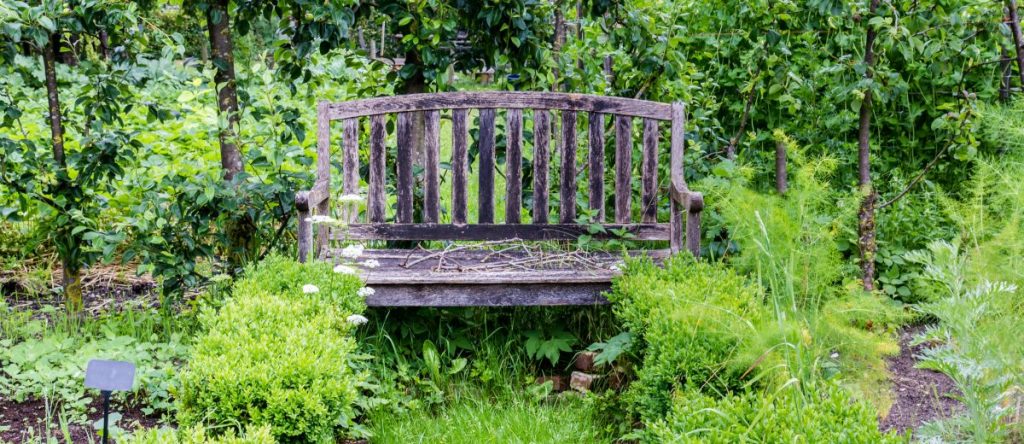Forest systems are one of the most stable ecosystems on earth. When we create edible forest gardens that mimic these systems, we get the ecological benefits of a forest with food as a bonus.
A detailed forest garden design will help you create an edible food forest that meets all your requirements.
However, if you start with an empty patch of land, creating a forest garden design can feel overwhelming. It’s often difficult to know where to start.
In this article, we look at what a forest garden is and why you should create one. We also take you through the steps to follow to layout your permaculture forest garden design.

What is a Forest Garden?
A forest garden is one of the food production strategies used in a permaculture garden or homestead. It is often also called a food forest or an edible forest.
Forest gardens usually include useful or edible plants specific to their location and climate.
When most people think of a forest garden, they imagine a large, untamed jungle, but this is not the case. Forest gardens mimic the edge of a forest, not the darkest depths.
They contain productive perennial plants stacked in layers like natural woodland systems.
There is a recognized system of forest garden planting that uses seven food forest layers. Yet, each forest garden is unique and can range from three layers in urban forest gardens to thirteen layered mature forests.
The seven most common forest garden layers are as follows:
- The tall tree or canopy layer
- The small tree or large shrub layer
- Shrub layer
- Herbaceous layer
- Ground cover layer
- Underground root layer
- Climber, Vine, or Vertical Layer
We feel that mushrooms play a significant role in a food forest garden and include an eighth layer.
- Mycelial or Fungal Layer
Layered forest gardens are a low-maintenance, sustainable way to grow plenty of food, even in urban areas.
You can have a small forest garden in your backyard because forest gardens are more about the principles than the size.

Can You Grow Vegetables in a Forest?
Perennial vegetables and vegetables that do not need full sun can be grown in your food forest.
However, it is often better to leave clearings for sun-loving annual vegetables or plant them on the edges of your food forest.
Consider devoting sections of your garden closer to the house to planting annual vegetables rather than in the forest garden.
In a forest garden, you aim to maintain a layer of ground cover and avoid disturbing the soil as much as possible. Meaning annual vegetables and root vegetables like potatoes are not ideal.
But, garlic, onions, beets, potatoes and carrots are often grown in forest gardens. It all depends on your personal preference and requirements.
Another thing to keep in mind is that it takes years for trees to mature. In the early years of a food forest garden, there is plenty of sunlight for sun-loving vegetables.
Later as the trees grow, you can replace them with shade-tolerant perennial plants.
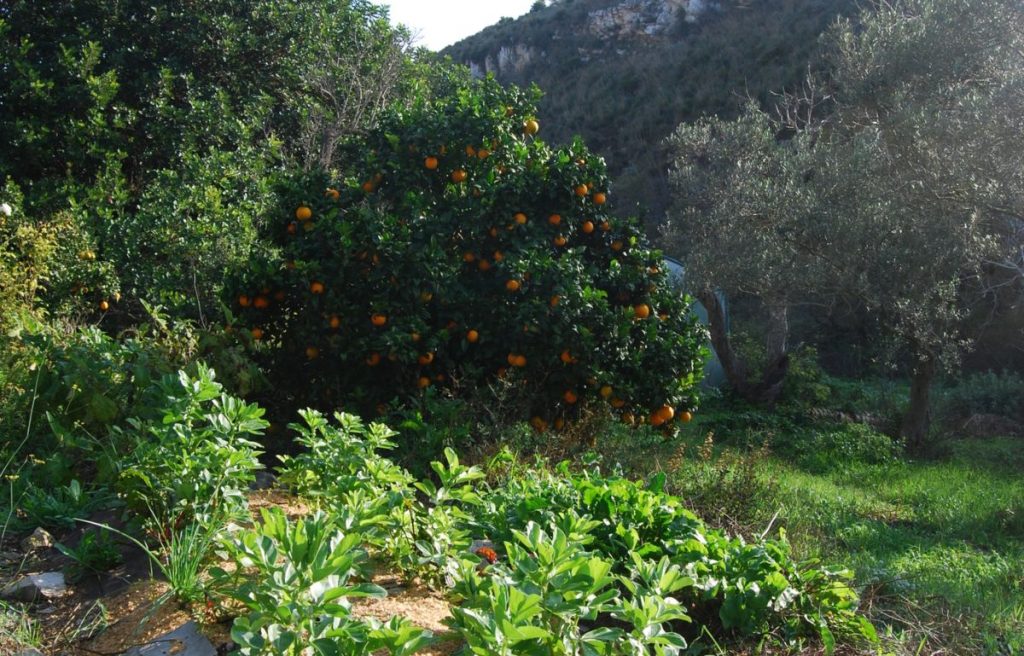
Why Create a Forest Garden?
Forest gardens are one of the most self-sustaining, abundant ecosystems you can create. They have a host of benefits for both the environment and you as a permaculture gardener or homesteader.
Annual vegetable gardens can be similar, but every forest garden is unique. Forest garden designs vary to meet the specific needs and requirements of their users.
Here are some of the top reasons to create a forest garden.
1. Forest Gardens Work With Nature
In temperate climates, an abandoned piece of land will eventually become a natural forest or woodland.
Nature moves towards woodland systems as they are self-sustaining and don’t require human input or maintenance to thrive.
Forest gardens mimic natural forest systems but with edible plants. They work with nature and fit somewhere between orchards and natural woodlands.
They are one of the lowest-energy-input permaculture systems.
2. Forest Gardens are Resilient
The layered structure and diversity of plants in a forest garden make them resilient in extreme weather conditions. When one plant struggles, another will succeed.
The trees and shrubs protect the soil from erosion, provide shade and cool the air creating a beneficial microclimate.
3. Forest Gardens are Biologically Sustainable Systems
In the tropics, forest gardens have existed for over twelve thousand years. Their sustainability comes from the diversity of plants and organisms and the interactions between species above and below ground.
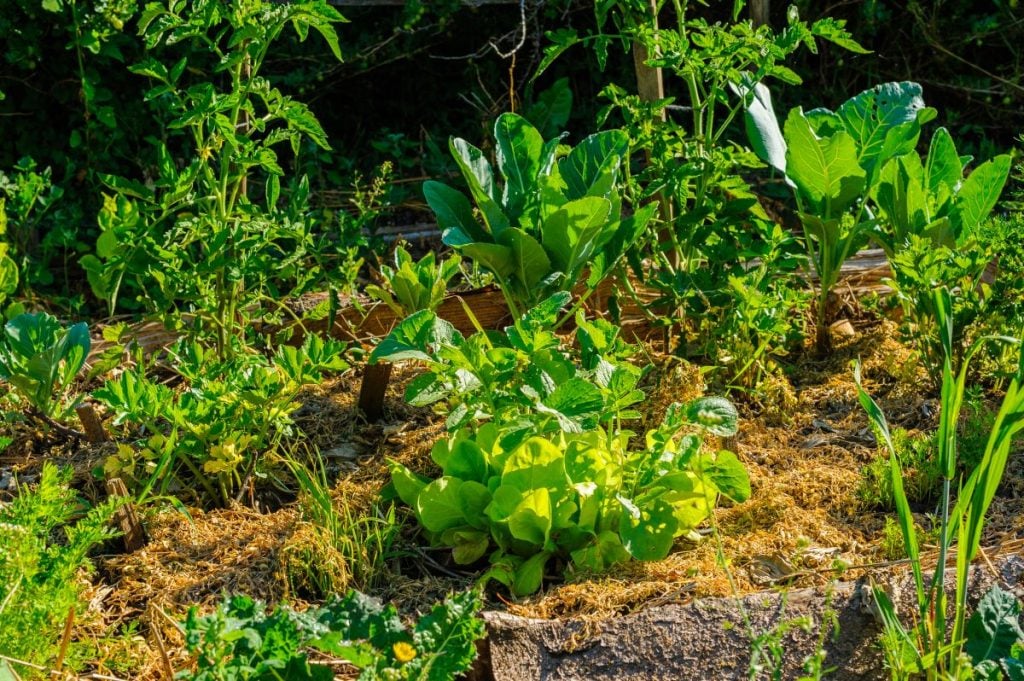
4. Forest Gardens are Beautiful and Abundant
Forest gardens often feel slightly wild and untamed. They are beautiful green spaces where people can relax, gather food, and reconnect with the abundance of nature.
Although most plants in forest gardens have direct or indirect uses, You can also include plants purely for their beauty if desired.
5. Forest Gardens are Beneficial for the Environment
Forest gardens have a lot of environmental benefits. They capture carbon dioxide and store it in the soil and woody biomass of the trees and shrubs.
They are excellent at retaining water after heavy rains and preventing flooding and erosion.
They also provide shelter and niches for insects and small animals.
6. Forest Gardens are Low Maintenance
A mature forest garden will contain a mixture of trees, shrubs, and ground-covering perennial plants. As plants or mulch cover the soil at all times, there is little to no weeding.
And the trees and shrubs need little maintenance apart from occasional pruning.
A mature food forest does not need digging, weeding, fertilizing or watering.
7. Forest Gardens Have Diverse Yields
Forest garden designs vary depending on the user’s specific requirements. They can yield a diverse range of products, both edible and functional.
8. Forest Gardens Have Commercial Potential
Most backyard forest gardens can generate some income as you often have surplus crops or products that you can sell.
But, you can also design a large forest garden for commercial-scale production, grow profitable crops and earn a decent income.
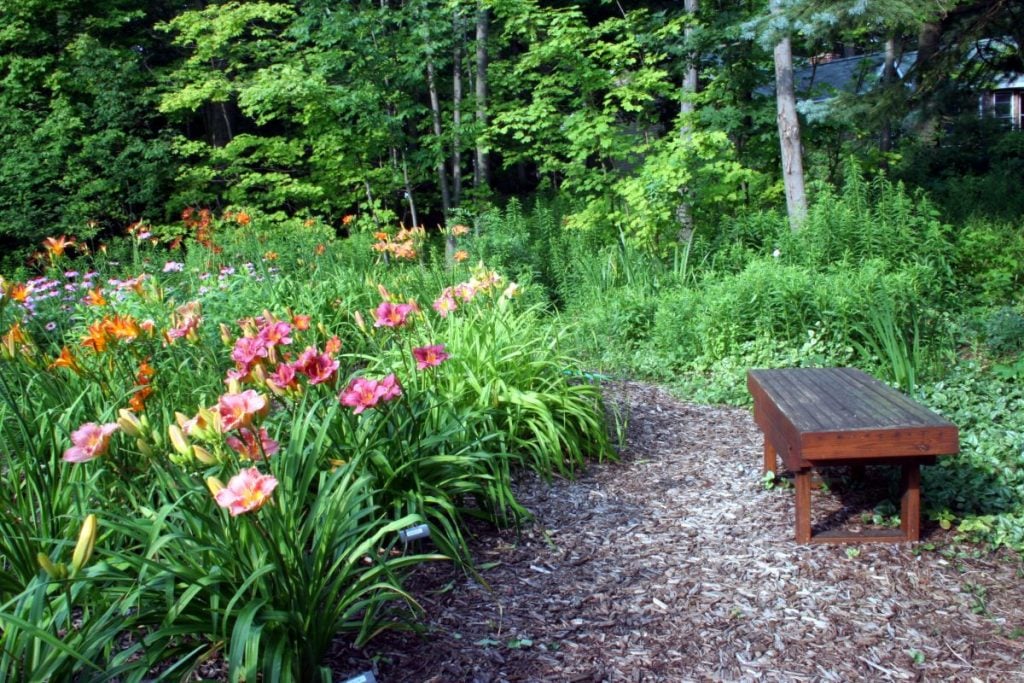
The Forest Garden Design Phases
Now that you have a better understanding of what a forest garden is and why you should consider creating one, you may be wondering where do I start or how do I plan a forest garden?
Forest garden design has several phases and is not as complicated as you may think.
The phases incorporate permaculture design processes to allow you to observe, plan and create the perfect forest garden for your needs.
Here are the forest garden design phases
1. Vision Phase
Before you do anything else, you need to sit down and consider your why. Why do you want to create a forest garden? What are you hoping to get from your forest garden?
A forest garden can yield so much more than edible plants. Deciding and noting your desired goals and outcomes makes it easier to choose your layout and plants.
Here are some possible outputs and products to consider.
Edible Yields
- Fruit
- Perennial vegetables
- Herbs
- Nuts and seeds
- Mushrooms and fungi
- Beverages
Non-Edible Yields
- Medicinal plants
- Scented plants
- Fibers
- Basketry and craft materials
- Soap plants
- Dye plants
- Canes and poles
- Building materials
- Firewood
Other Yields or Uses
- Educational project
- Income stream
- Wildlife habitat
- Party venue
- Relaxation space
- Aesthetic and spiritual benefits
These are only some of the possible yields. The options are endless. Use your imagination, research ideas and jot down everything you would like. You can always narrow down the list at a later stage.
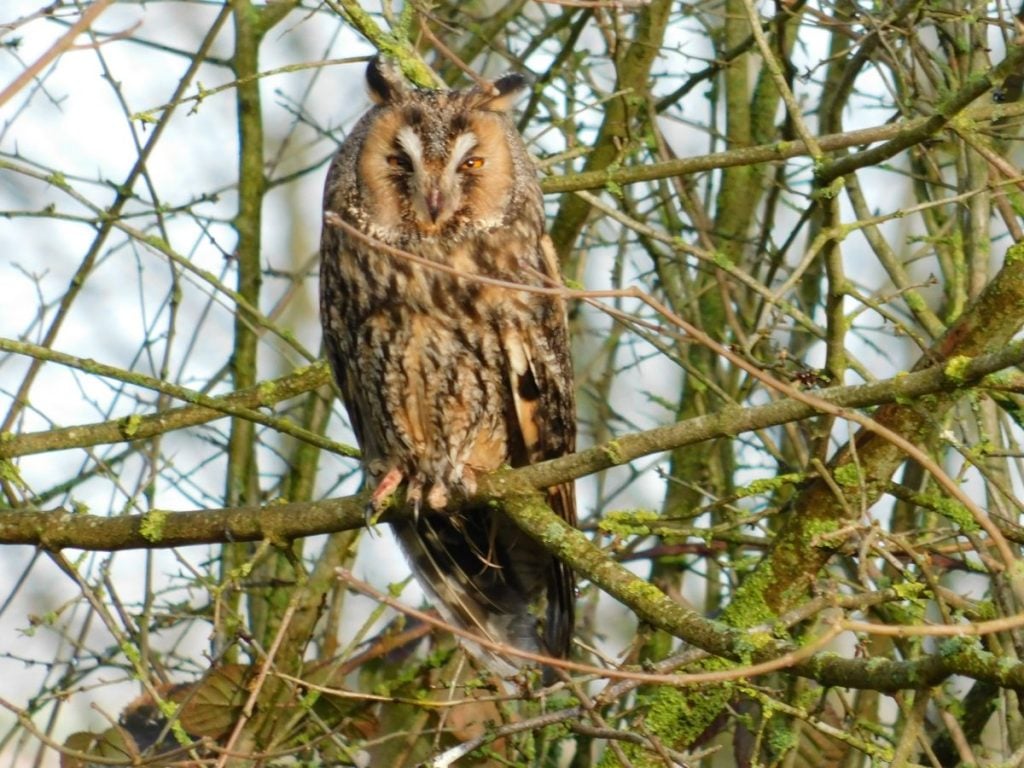
2. Assessment Phase
In this phase, it is time to look at what you have to work with and decide where to locate your food forest. Map, collect information and find out as much as possible about the existing site.
Get a thorough understanding of the site’s potential, resources and limitations. Then go back to your list of desired goals and outcomes and decide what will or will not work.
During the assessment phase, it is important to consider the following:
- Sunlight – Focus on summer and winter sun patterns. Which areas of the site are sunny and shady now? And what will they be like with established trees?
- Wind – Is the site sheltered? What are the prevailing winds? And does the wind differ from summer to winter?
- Rainfall and water – Consider how much rain falls in the area and when? How will water flow through the site, and can you create a system that does not need irrigation?
If irrigation is necessary, how can you capture and store water on-site?
- Climate – Is the site prone to frosts or extreme heat? What are the average temperatures and conditions?
- Slope – The site’s typography will influence the flow of water and how you plan your pathways etc.
- Soil – Determine the soil type, fertility, and the soil pH of your site.
- Wildlife – Observe and note any wildlife that visits or lives in the area. Plan and plant your forest garden with wildlife in mind. It will make your life easier.
You can use the plant and wildlife interactions to your advantage and create a more balanced ecosystem.
- Access and movement – Consider how you will access and move through your forest garden to harvest, prune and relax. Where is the forest garden relative to other elements on your property? How will you access it?
Create a base map at a scale of 1:100 or 1:200 of the existing site to use when designing your food forest. You can use Google Maps for this or create a hand-drawn map.
Remember to include any existing fixed elements or structures on your map.
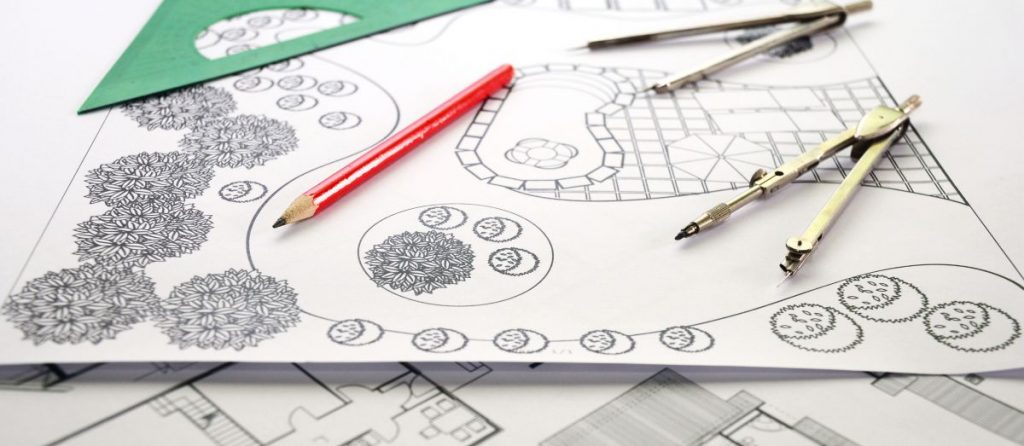
3. Planning Phase
During the planning phase, you will use the information you acquired during the first two phases to start putting ideas together.
Now is the time to research plants that will thrive in your specific climate and give you the outputs you desire. It is also during this phase that you consider your infrastructure requirements.
During this phase, you should also source potential suppliers and decide whether to buy plants or grow your own from seeds or cuttings.
Draw up a proposed time scale for the implementation of your forest garden. Give yourself a few years rather than trying to plant everything and achieve all your goals at once.
A forest garden is a work in progress that is constantly evolving.
4. Design Phase
With all the preparation you have done in the previous phases, the design phase should be relatively simple and a lot of fun.
Now you will complete your patch designs of plant guilds and create your forest garden design.
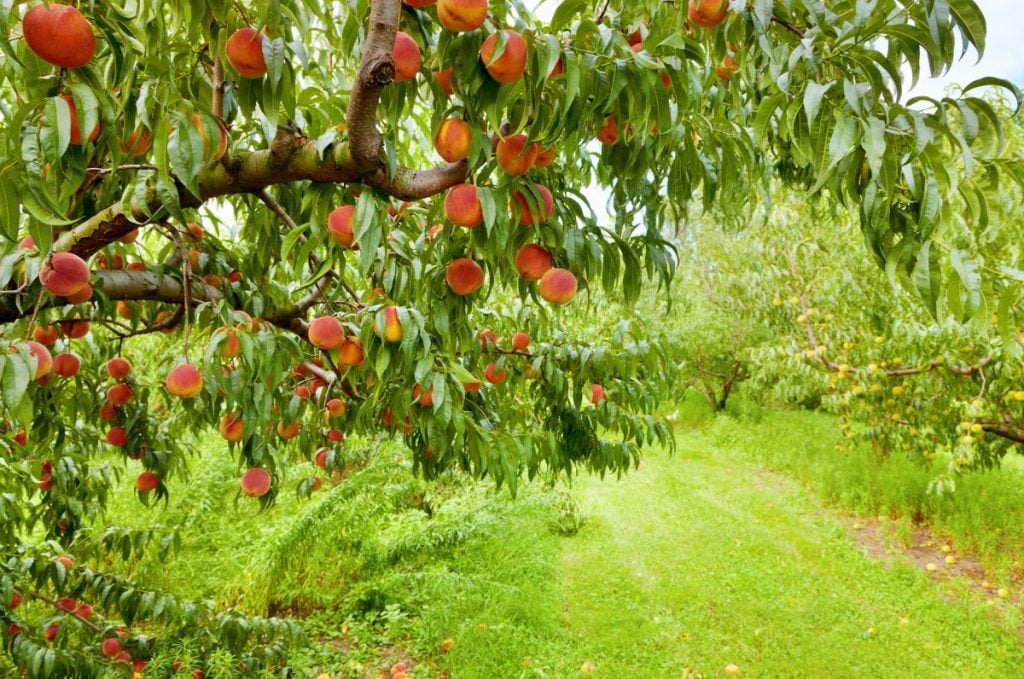
How to Design a Forest Garden – Step by Step
Now that you have a better idea on where to start and the phases involved while planning and designing your forest garden, this step by step guide will help you through the process.
Step 1: Choose a General Layout
The first step in designing your food forest, and part of the planning phase, is to choose a general layout. Which is best for you will depend on your goals and your site’s characteristics.
These three basic layouts are the most common.
1. Savanna
Savanna layouts are better suited to the commercial production of fruits, nuts, and herbs. This layout is most often implemented in larger-scale food forests and uses equidistant rows for efficient machine harvesting.
This layout is ideal for alley cropping, growing companion plants in the alleyways between trees, and silvopastoral systems that integrate trees and grazing for domesticated animals.
2. Orchard
Both commercial production and backyard forest gardens can utilize an orchard layout. This layout has equidistant rows and trees spaced at regular intervals.
Orchard forest gardens are similar to traditional orchards but contain various complementary species, not just one type of tree.
3. Woodland
The woodland layout mimics a natural mid to late succession woodland. It provides an opportunity to create the most interesting, varied, and productive patterns of trees, shrubs, and herbs.
This layout is ideal for smaller forest gardens and backyard food production but can also scale to farm size.
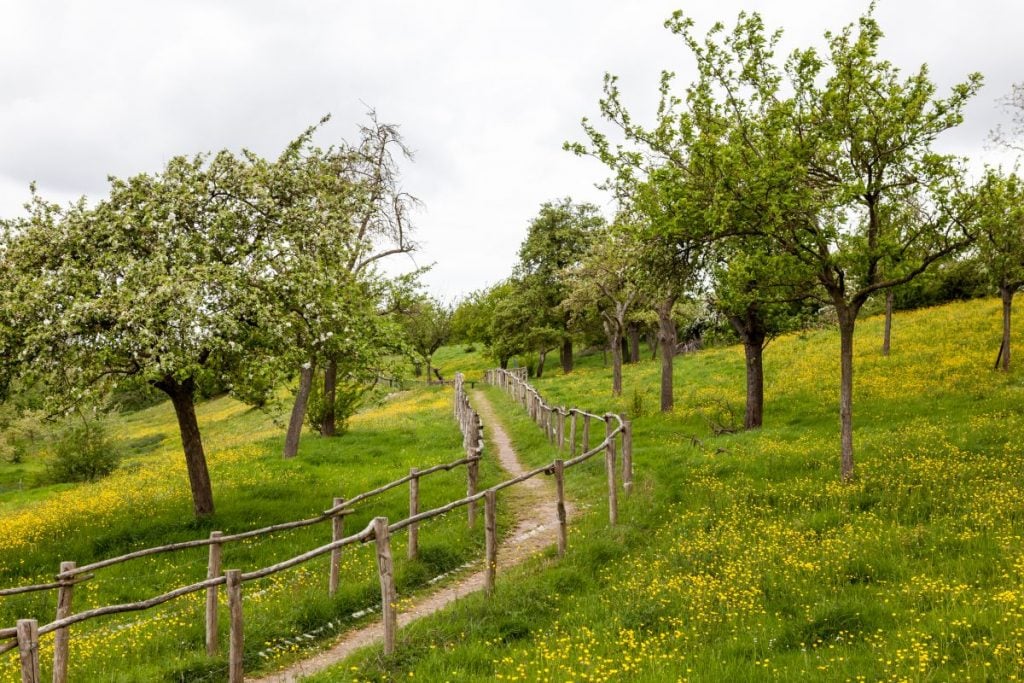
Step 2: Plan Your Infrastructure
Start your design by planning the most permanent elements of your forest garden, the water, access and structures.
1. Water
Water planning comes first, as, without water, your forest garden will not thrive. Consider suitable places for water tanks, irrigation lines or other natural water capturing elements.
The water systems that you develop will become permanent features that affect other components in your layout.
2. Access
After designing the water systems, consider where to put your access roads or paths. They will direct your movement in and around your forest garden in the future.
Remember, each plant guild you create becomes a mini-ecosystem that should ideally not be stepped on.
Don’t forget to design paths that will be wide enough for both you, wheelbarrows and other equipment. You will need to get these in and out for harvesting and annual pruning.
3. Structures
Now consider fencing requirements and any structures you would like to include in your forest garden. You can use fencing to protect certain zones of the forest garden from animals.
And may want to create a seating area for relaxation or structures for storing tools etc.
Effective infrastructure design reduces maintenance, maximizes productivity and provides beneficial animal habitats, creating a space you can enjoy for many years.
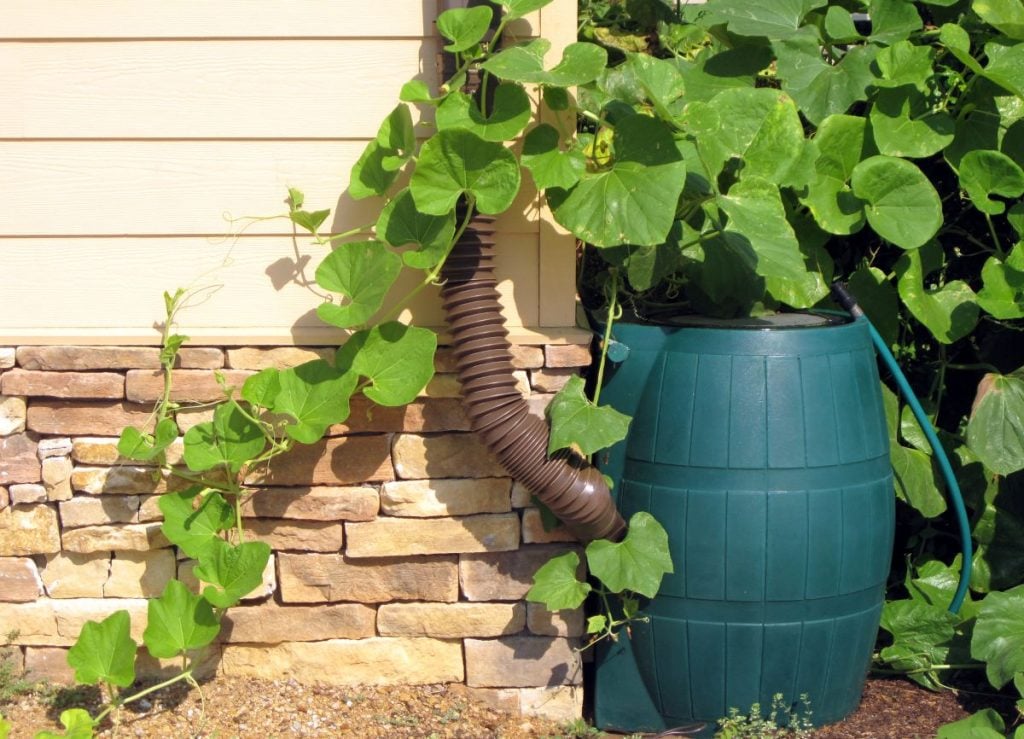
Step 3: Make a master list of plants
Once your infrastructure is in place on the site map, it is time to choose plants for your forest garden. At first, this may seem daunting, but if you narrow the plants into categories and tackle them one at a time, it is easier.
The goal at this stage of the planning phase is to create a master list of plants. Include plants that you want and species that fulfill a specific function in the forest garden.
Where possible, these should also be well-adapted plants that suit your climate.
Create a spreadsheet using categories based on a plant’s purpose or function in your forest, such as food production, gathering and retention of nutrients, beneficial pollinator plants, ground cover, hedge plants, etc.
Below is a list of seven different functions that a permaculture forest garden guild should include:
- Food for us – Plants that provide edible harvests like nuts, fruits, vegetables, legumes, etc.
- Food for the soil – Plants that provide nutrients to the soil.
- Climbers – Plants that help you make the most use of vertical space.
- Supporter Plants – Plants that provide support for climbers.
- Miners or Diggers – Plants with deep roots or tubers that open the soil and bring up nutrients.
- Groundcovers – These protect the soil, provide shade, hold moisture, and suppress weeds.
- Protectors – Plants that protect others in the system like repellents, attractors, hedges, etc.
Do some research and list all the plants in each category that you would like to include. If there is a plant species that you want but know won’t work in your climate. Try to find an ecological equivalent.
A similar species that fills the same role in habitats like yours worldwide.
Plants For A Future is a valuable free resource for beginners designing their first forest garden. It provides information on useful temperate plants, including their edible and medicinal qualities, functions, and habitat preferences.
Remember to Include native and naturalized species that grow well in your area.
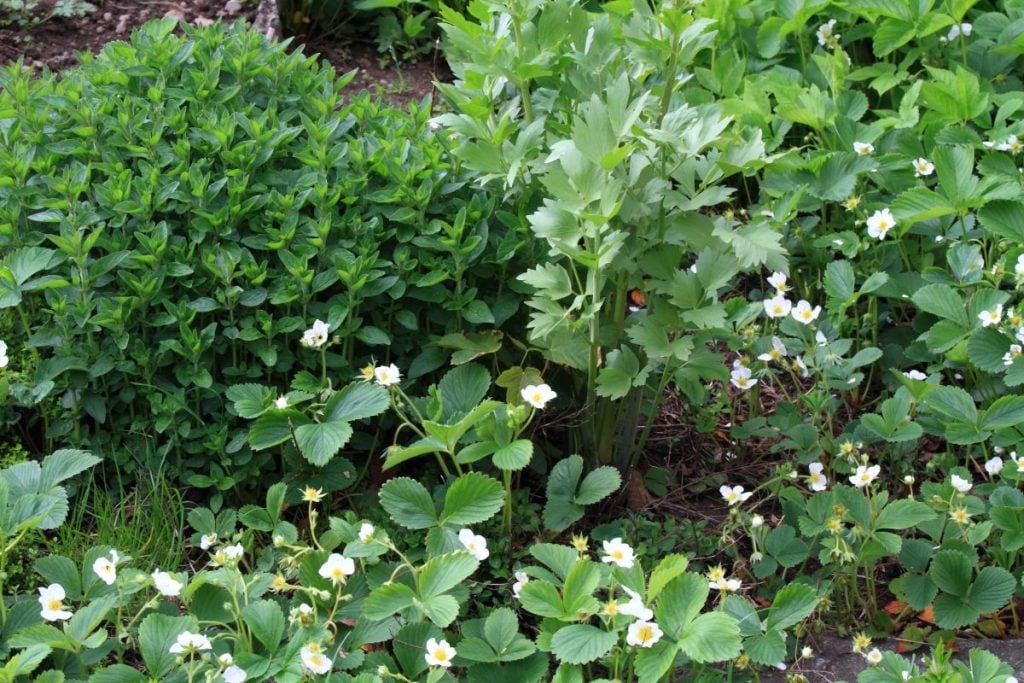
Step 4: Create Plant Guilds
Using your master list of plants, you are now going to create mutually beneficial plant guilds. Plant guilds are the core of permaculture forest gardening and an integral part of the design process.
A guild is a diverse group of plants, trees, animals and insects that work together for the benefit of all species involved.
When creating guilds, you start with your trees and work down and outwards in layers.
Your guild will consist of a group of plants that work together to support your tree. In return, they enjoy the shelter and biomass produced by the tree.
The goal when creating plant guilds is to recreate a naturally sustaining forest environment where plants thrive.
Try to underplant your trees with useful, multifunctional plants that could naturally grow together.
Free Permaculture has information on guilds, companion plants, and polycultures with resources, examples and spreadsheets to help you create your forest garden guilds.
Step 5: Create Patch Designs
Patch designs define the planting areas and plant spacing in your forest garden. Create your patch designs on your site or base map.
Depending on the layout you have chosen for your food forest, savanna, orchard or woodland. A patch could be a row, a contour or a grouping of plants.
Small backyard food forests often only need one woodland patch design.
The most important aspect when creating your patch designs is deciding the planting distance.
Here are some steps to take when creating your food forest patch designs.
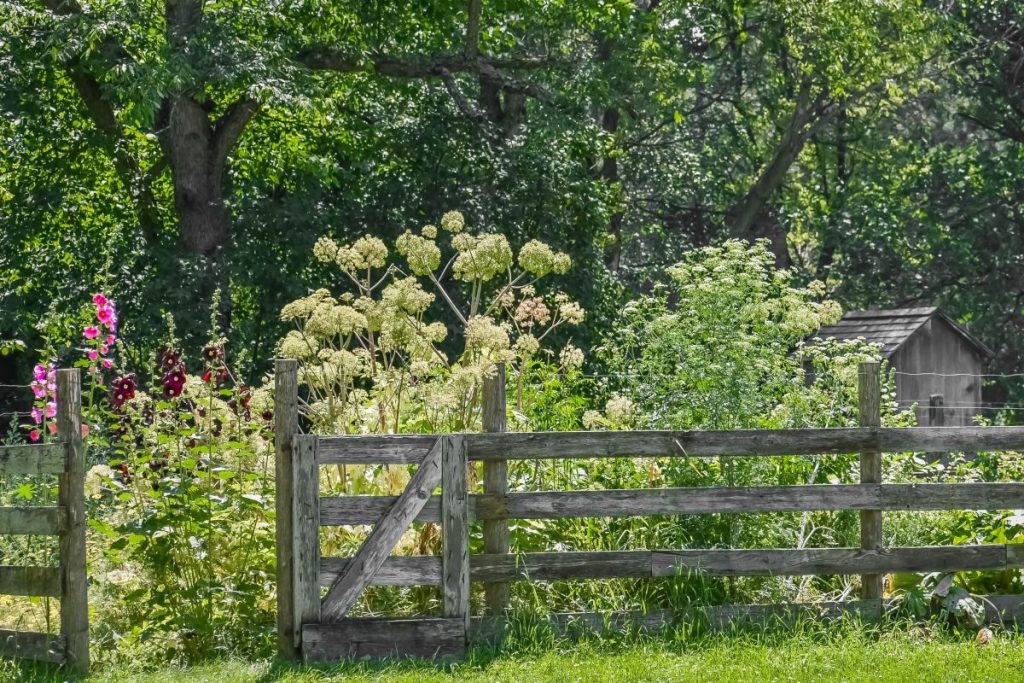
1.Consider the Boundaries
If starting from scratch on exposed land, you may need to establish some form of shelter from wind or frost.
Creating a hedge of hardy trees and shrubs around your site is an effective way to protect fruit or nut trees and less hardy shrubs.
In urban settings, you may want to create a hedge not just as shelter but also to provide privacy and reduce dust, pollution and noise from nearby roads.
If possible, choose multifunctional hedging plants that provide wildlife benefits, edible crops or other yields.
Show these plants on your layout, taking their mature size into consideration
2. Position the Canopy Trees
Once your boundaries are in, start your forest garden patch design by positioning the fruit and nut “canopy” trees. These are important and form the backbone of your forest.
Their location determines the positioning of all the other plants.
The biggest mistake people make when designing a forest garden is planting their trees too close together.
A common way to determine the correct spacing for your trees is to use the “crown touching rule.”
Research the predicted mature crown size of the species you plan to use and then place your trees a crown’s diameter apart.
If you have less than ideal soil conditions or want to make sure your understory plants get enough light, add 25 to 50 percent more distance between your trees.
It is advisable to plan the canopy layer using the scale map of your site that you created in the assessment phase. Doing so allows you to include canopy trees at the correct scale and assists with placement.
3. Add the Shrubs and Bushes
Fit smaller trees, shrubs and fruit bushes into the spaces between the canopy trees. Create a planting plan for these and include them on your map.
Remember to incorporate nitrogen-fixing shrubs and bushes to help build and maintain soil fertility.
4. Design the Ground Layer
Once you complete the canopy tree, shrub and bush placement, it is time to design the lower forest garden layers.
Besides providing perennial salad and vegetable crops, one of the main functions of the lower level plants is to create a living mulch of ground covering plants.
These discourage invasive species, maintain soil moisture and prevent compaction.
Plants to consider for these layers are edible plants, nitrogen fixers and aromatic plants with antifungal essential oils.
Make notes on your map to show the placement of the smaller plants in the groundcover and herbaceous layers. These complete your forest garden guilds.
Your forest garden design is now complete. It is time to start preparing the soil and planting.
Remember, this design is your starting point and will more than likely evolve as you learn more, your requirements change, and the plants mature.
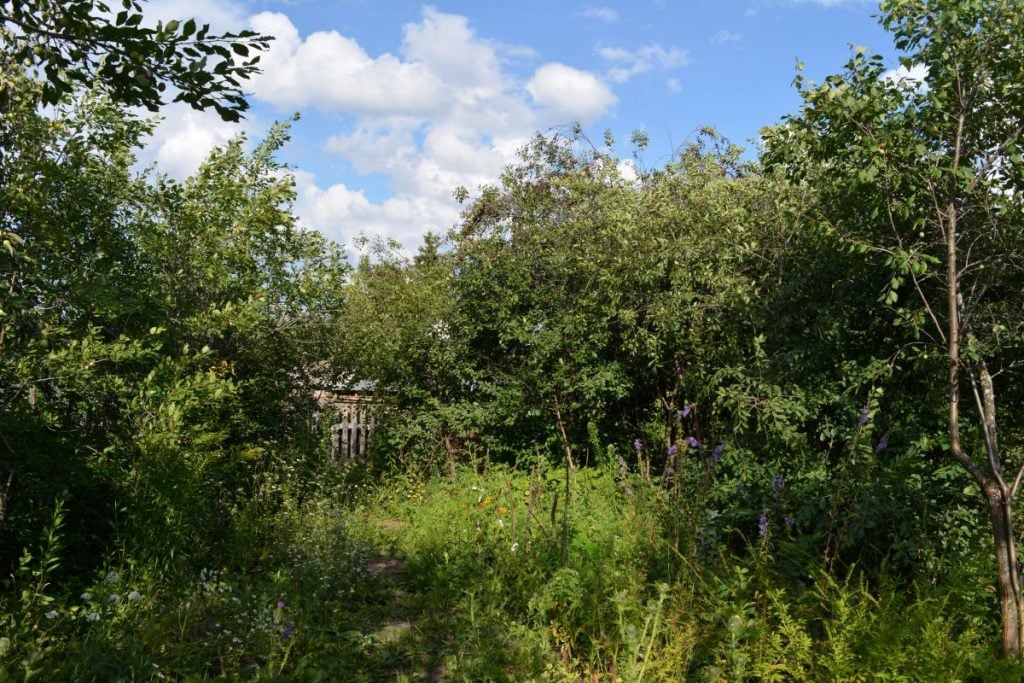
Pros and Cons of Designing a Forest Garden
Like any other permaculture system, designing a forest garden has both pros and cons. But, we feel the pros far outweigh the cons.
Here are a few pros and cons to consider when deciding if designing a forest garden is the best option for you.
Pros
- A forest garden is a long-term, abundant, sustainable system for growing food and other produce.
- Once established, forest gardens are low maintenance and don’t need much work other than harvesting and pruning.
- Forest gardens help to restore soil, biodiversity, and habitat while creating an edible yield.
- Forest gardens produce a wide range of yields, optimizing the space they occupy.
Cons
- Initial planting to establish your forest garden requires a large number of different plants and substantial work. However, you can stagger the planting over a few years to reduce the upfront costs and labor.
- You need patience as it takes several years for your forest garden to become a self-sustaining ecosystem.
Final Thoughts
Although creating a forest garden design may seem daunting at first. When you break it down into steps, it’s manageable and fun.
Forest gardens tend to evolve as they grow. But, if you create your initial forest garden design with your final requirements in mind, you will have a sustainable, low maintenance system that provides the desired yields.
Forest gardens are one of many permaculture food production systems. To find out more about permaculture and other food production systems, visit our Permaculture Resource Hub.
